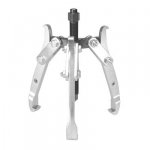Guys! Great news, I got it off, and confirmed that the connecting rod bolts had backed off maybe 3/8ths of an inch, as happened to someone else on this forum.
I have some pictures to post here for the record, so that if anyone else comes across this thread in the future via search or whatever, they can see what may be involved to fix it.
For starters, the blade holder was SERIOUSLY rusted on. After many failed attempts at making it budge (in a manner that didn't break anything), and after sitting in PB blaster for 1.5 weeks, I finally decided to get violent with it. The general procedure was to get the largest ratchet I had, tighten the forcing screw with as much force as can be managed, then pull the hammer and start striking upwards from the bottom of the holder. Of course, this much force caused the heavy steel blade holder to start to warp, but I knew I would be replacing it going in. Care just needs to be taken so that this is the only part needing replacing. Also, at the earliest stages, when the most force needs being applied, the retaining bolt for the holder should probably be nearly all the way in, to give it maximum thread to push against when you start applying these huge forces.
Effectiveness was gauged by how much 'progress' I could make in turning the forcing screw. 'Tapping' the forcing screw was nearly useless. I would make 'forceful strikes' against the bottom of the holder, maybe 10 to 12, distributed around the rim of the holder, before I would stop making progress and had to take up the slack in the forcing screw.
After 8 or so iterations of this, and realizing I was finally starting to make progress (about 2mm worth of progress, but I had been making none before), my resolve was strengthened. This wasn't just some guy removing a stuck blade holder from his mower engine, this was a MAN laying waste to an enemy that had defeated him repeatedly over the past week or so.
Eventually, after moving it about 4mm, I found that I could 'almost' move it entirely without the hammer (at this point I had an enormous breaker bar on the forcing screw and a 2 foot lever that rested against my knee so that it wouldn't move on me as a heaved against the breaker bar). All of the sudden - BOOOM!!!! My ears were ringing and as I realized what happened, I was looking around for what had broken (and hoping it wasn't attached to the rented gear puller). Imagine my surprise when I noticed the blade holder had moved a 1/4 inch! :wink: After picking up the breaker bar (which flew into my knee) and the lever I was using to brace it (which flew across the shop), I got back to work!
Four 'Boom!'s later (all of which were considerably quieter), I had the thing off!!! :smile:
Pics below, and even one of the culprit head bolts. I imagine they underestimated the torque specs on these babies - I have never heard of any kind of connecting rod bolt backing off. Guessing that these are probably torque-to-yield, so I will probably just check the crank for damage, then retighten them to spec (since it took years to back off on us, not much to gain by overtightening).
Thanks guys!
~CM-NC








